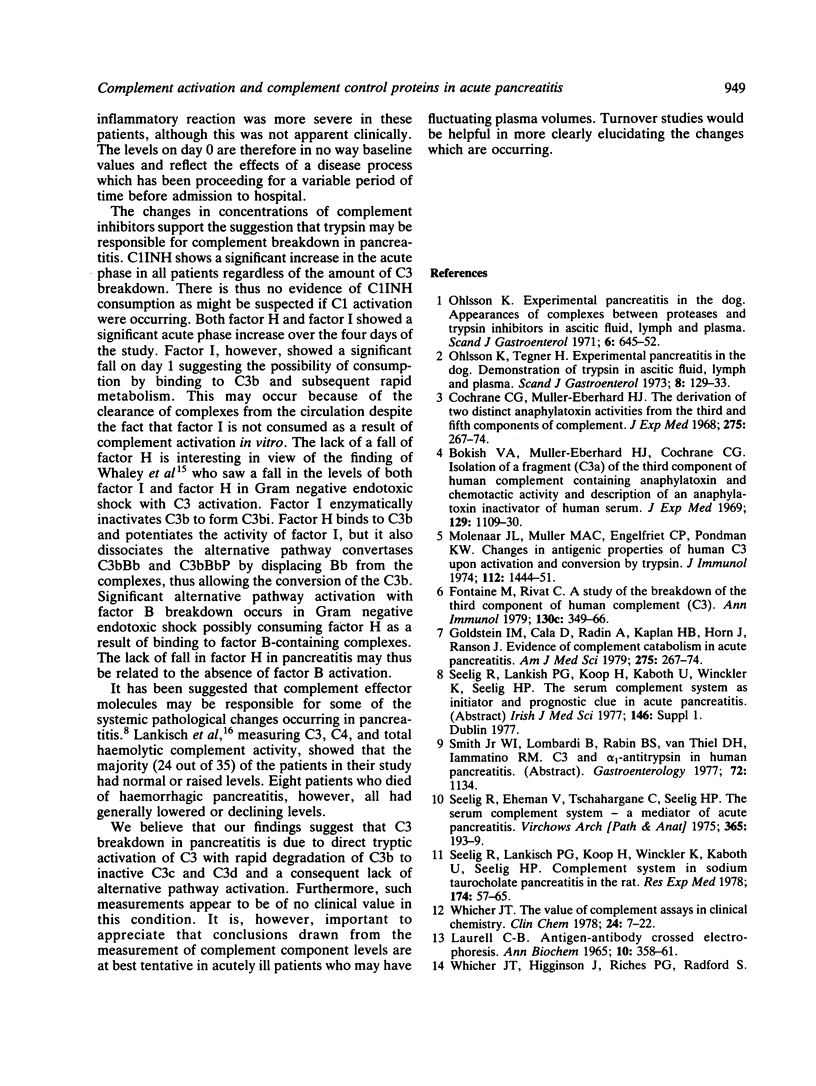Abstract
Serum levels of the complement proteins C3, C4, C1 inhibitor (C1 INH), factor I (C3b inactivator) and factor H (BIH) and plasma levels of cleavage products of C3 (C3c) and factor B were measured in 26 patients with acute pancreatitis. Breakdown of C3 occurred in 19 patients, as shown by a reduction in C3 level and the presence of C3c. C4 levels, however, did not fall and factor B breakdown products were not detected, thus suggesting that enzymatic cleavage of C3 occurred without significant involvement of either the early classical pathway or the alternative pathway. C1 INH and factor H both showed increases, presumably reflecting an acute phase response. Factor I showed an initial fall followed by a rise. There was no correlation between the presence or extent of C3 breakdown and the clinical condition of the patients. It is concluded that C3 cleavage in pancreatitis probably results from tryptic activity and that the measurement of complement components has no part to play in the management of the disease.
Full text
PDF






Selected References
These references are in PubMed. This may not be the complete list of references from this article.
- Bokisch V. A., Müller-Eberhard H. J., Cochrane C. G. Isolation of a fragment (C3a) of the third component of human complement containing anaphylatoxin and chemotactic activity and description of an anaphylatoxin inactivator of human serum. J Exp Med. 1969 May 1;129(5):1109–1130. doi: 10.1084/jem.129.5.1109. [DOI] [PMC free article] [PubMed] [Google Scholar]
- Fontaine M., Rivat C. A study of the breakdown of the third component of human complement (C3). Ann Immunol (Paris) 1979 May-Jun;130C(3):349–366. [PubMed] [Google Scholar]
- LAURELL C. B. ANTIGEN-ANTIBODY CROSSED ELECTROPHORESIS. Anal Biochem. 1965 Feb;10:358–361. doi: 10.1016/0003-2697(65)90278-2. [DOI] [PubMed] [Google Scholar]
- Lankisch P. G., Koop H., Kaboth U. Serum complement factors in human acute pancreatitis. Hepatogastroenterology. 1981 Oct;28(5):261–263. [PubMed] [Google Scholar]
- Molenaar J. L., Müller M. A., Engelfriet C. P., Pondman K. W. Changes in antigenic properties of human C3 upon activation and conversion by trypsin. J Immunol. 1974 Apr;112(4):1444–1451. [PubMed] [Google Scholar]
- Ohlsson K. Experimental pancreatitis in the dog. Appearance of complexes between proteases and trypsin inhibitors in ascitic fluid, lymph, and plasma. Scand J Gastroenterol. 1971;6(7):645–652. doi: 10.3109/00365527109181147. [DOI] [PubMed] [Google Scholar]
- Ohlsson K., Tegner H. Experimental pancreatitis in the dog. Demonstration of trypsin in ascitic fluid, lymph and plasma. Scand J Gastroenterol. 1973;8(2):129–133. [PubMed] [Google Scholar]
- Seelig R., Ehemann V., Tschahargane C., Seelig H. P. The serum complement system--a mediator of acute pancreatitis. Virchows Arch A Pathol Anat Histol. 1975;365(3):193–199. doi: 10.1007/BF00434038. [DOI] [PubMed] [Google Scholar]
- Seelig R., Lankisch P. G., Koop H., Winckler K., Kaboth U., Seelig H. P. Complement system in sodium taurocholate pancreatitis in the rat. Res Exp Med (Berl) 1978 Dec 27;174(1):57–65. doi: 10.1007/BF01851939. [DOI] [PubMed] [Google Scholar]
- Whicher J. T., Higginson J., Riches P. G., Radford S. Clinical applications of immunofixation: detection and quantitation of complement activation. J Clin Pathol. 1980 Aug;33(8):781–785. doi: 10.1136/jcp.33.8.781. [DOI] [PMC free article] [PubMed] [Google Scholar]
- Whicher J. T. The value of complement assays in clinical chemistry. Clin Chem. 1978 Jan;24(1):7–22. [PubMed] [Google Scholar]


